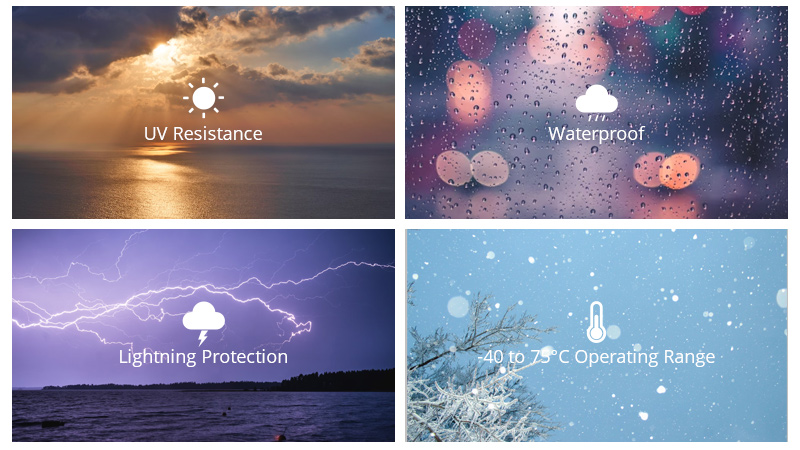Outdoor Ethernet Cable Guide
Outdoor Ethernet cables are crucial for establishing reliable network connections in outdoor environments, enduring varying weather conditions, and maintaining high-speed data transmission. This guide will explore the outdoor Ethernet cable and help you decide on your needs.
What is Ethernet Outdoor Cable?
Ethernet Cable for Outdoor Use Definition
Ethernet outdoor cables are network cables specifically designed for outdoor use. Unlike indoor Ethernet cables, outdoor cables use harsh environmental conditions such as temperature fluctuations, moisture, UV radiation, and physical wear and tear.
Here are some key features and characteristics of Ethernet outdoor cables:
Weather-resistant: Outdoor Ethernet cables are designed to resist moisture, snow, rain, and other weather conditions, ensuring reliable performance in outdoor environments.
UV-resistant: The outer jacket of outdoor cables is typically UV-resistant to protect against damage from prolonged exposure to sunlight.
Durable Construction: These cables often feature rugged and enhanced durability to withstand physical stress and environmental hazards.
Shielding: Many outdoor Ethernet cables use shielding to minimize electromagnetic interference (EMI) and radio frequency interference (RFI), ensuring stable and high-speed data transmission.
Burial Grade: Some outdoor Ethernet cables are designed for direct burial, allowing them to be installed underground without needing a conduit.
Temperature Tolerance: Outdoor cables are built to handle a more comprehensive temperature range than indoor cables, ensuring reliable operation in extreme hot or cold conditions.

The Common Scenarios for Running Ethernet Cables Outside
Running Ethernet cables outside can be necessary for various scenarios where wired network connectivity is required beyond indoor spaces. Here are some common scenarios where running an Ethernet cable outside may be required:
Connecting Buildings
If you have multiple buildings on a property, such as a house, garage, or workshop, you may need to run Ethernet cables between them to establish a wired network connection.
Outdoor Security Cameras
Installing outdoor security cameras often requires Ethernet cables to connect them to a network video recorder (NVR) or a power-over-Ethernet (PoE) switch for data and power transmission.
Outdoor Wi-Fi Access Points
Outdoor Ethernet cables connect outdoor Wi-Fi access points to the main network, extending Wi-Fi coverage to outdoor areas such as gardens, patios, or pool areas.
Garden or Landscape Lighting Systems
Intelligent lighting systems in gardens or landscapes may require Ethernet connections for centralized control and management, especially in larger installations.
Outdoor Digital Signage
Public displays, digital billboards, or outdoor informational kiosks may require Ethernet connectivity for content delivery and remote management.

Is Any Ethernet Cable Suitable for Outdoor Use and Why Do We Need Outdoor Cable?
Not every Ethernet cable is suitable for outdoor use. To avoid damage and maintain a stable connection when networking outdoors, it's crucial to use cables specifically designed for outdoor use.
Using indoor Ethernet cables outdoors can lead to several consequences due to their lack of appropriate protection against environmental factors.
Firstly, these cables are not designed for outdoor use. Exposure to moisture can cause the cables to deteriorate, leading to signal loss or even complete failure over time. UV rays can degrade the insulation and jacket of the cable, reducing its lifespan and performance.
Secondly, indoor cables are not built to handle extreme temperatures, which can lead to thermal expansion and contraction, further compromising the cable's integrity. Additionally, they lack the physical durability needed to withstand outdoor hazards like physical impact, rodent damage, or accidental cuts.
In summary, using indoor Ethernet cables outdoors increases the risk of cable damage, network instability, and signal loss. Choosing cables designed for outdoor use is essential for maintaining a reliable and long-lasting network connection.
Indoor Ethernet Cable vs Outdoor Ethernet Cable, What's the Difference?
Indoor and outdoor Ethernet cables cater to distinct environments and purposes, showcasing notable differences.
Jacket Material
The primary distinction between indoor and outdoor Ethernet cables lies in their jacket material. Indoor cables usually feature a PVC jacket, whereas outdoor ones use a durable material like PE to resist UV radiation, water, and extreme temperatures.
Water Resistance
Indoor Ethernet cables usually lack water resistance, while outdoor Ethernet cables, also known as waterproof cables, are designed to endure water and moisture exposure. Some outdoor cables incorporate water-blocking gel or tape to prevent water damage.
Temperature Resistance
Outdoor Ethernet cables are built to endure extreme high and low temperatures, while indoor cables are generally suited for temperature-controlled settings and may not handle extreme fluctuations.
UV Resistance
Outdoor Ethernet cables are engineered to resist UV radiation from the sun, which can degrade their jacket material over time. Their PE jacket is UV-resistant, ensuring the cable maintains its integrity over prolonged use.
Conductor Protection
Outdoor Ethernet cables frequently feature enhanced conductor protection against environmental hazards like moisture, dust, and debris. This can encompass a foil shield, braid shield, or armored casing.
FAQs and Solutions about Exterior Network Cable
Installation Issues
Q1: What precautions should I take when installing Ethernet outdoor cables?
A1: When installing outdoor Ethernet cables, it's essential to:
Use weatherproof connectors and junction boxes.
Ensure proper grounding to protect against electrical surges.
Follow the manufacturer's guidelines for bending radius and pulling tension.
Test the cables before burying them to avoid future issues.
Q2: Can I use indoor Ethernet cables for outdoor installations?
A2: Indoor Ethernet cables are not designed to withstand outdoor conditions. Using them outdoors can result in quicker degradation. Always use cables specifically designed for outdoor use.
Performance Concerns
Q3: How does weather affect the performance of Ethernet outdoor cables?
A3: Weather conditions like rain, snow, and extreme temperatures can impact the performance of outdoor Ethernet cables. Moisture can cause signal loss and corrosion, while temperature fluctuations affect cable flexibility and conductivity. Choosing cables with proper weather-resistant features can help mitigate these issues.
Q4: What factors can cause slow network speeds with outdoor cables?
A4: Several factors can contribute to slow network speeds:
The cable length exceeds the recommended limit.
Poor cable quality or damage.
Interference from other electronic devices.
Incorrectly configured network settings.
Maintenance and Troubleshooting
Q5: How should I maintain outdoor Ethernet cables to ensure longevity?
A5: Regular maintenance can extend the lifespan of outdoor Ethernet cables:
Inspect cables for physical damage or wear regularly.
Clean connectors and junction boxes to remove dirt and debris.
Check grounding connections for corrosion and proper functionality.
Q6: What should I do if I encounter connectivity issues with outdoor Ethernet cables?
A6: If you experience connectivity issues:
Check for visible damage or cuts in the cables.
Test the cables using a cable tester to identify any faults.
Verify that connectors and junctions are securely attached.
Ensure proper grounding and electrical connections.
Conclusion
In conclusion, outdoor Ethernet cables are vital in establishing robust and reliable network connections in challenging outdoor environments. These cables are designed to withstand moisture, UV radiation, temperature fluctuations, and physical wear, ensuring stable and high-speed data transmission. Choosing a suitable outdoor Ethernet cable tailored to specific needs is crucial for maintaining a long-lasting and efficient network connection.










